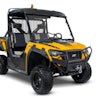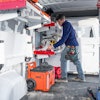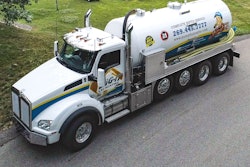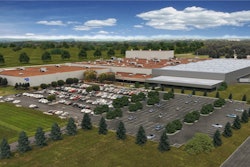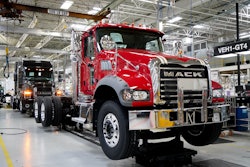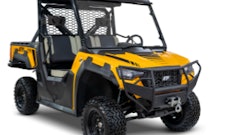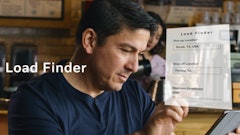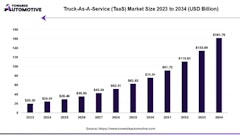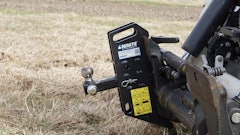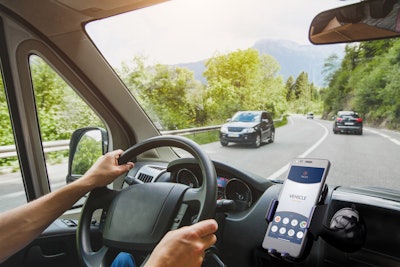
It’s hard to dispute the return on investment from many of the recent technologies being implemented to monitor driver behavior and protect your construction business from unwarranted claims. The payback can often be measured in mere months.
But the rapid evolution of technologies designed to protect drivers in a company fleet means many are still in their infancy. The adoption of these technologies will depend on a series of factors.
“In technology there’s a triangle,” says Keith Schneider, president and CEO, GPS Trackit. “Three things have to happen — cost needs to come down, the value to the customer needs to be very high and it has to be easy to use. If those three things don’t align, you are in the early adopter stage and you’re living at a 20% market penetration. When that triangle aligns, you’ll see penetration go from 20% to 60%.”
Telematics video technology is an area that is currently witnessing rapid adoption. “In video, we are just entering those pieces aligning,” says Schneider. “Costs are coming down, value is getting very high and the ease of use is getting much better. The data rates are actually coming down, also. So, the stage has been set for that adoption to go from the 20% to 25% range now to over 60% over the next couple of years.”
Distracted Driving Tops The List
Distracted driving tops the list of dangerous activities on roads and on the jobsite, as well.
 Vehicle location is supplemented with speed, acceleration and G-force measurements to provide interesting insights into the risks facing drivers.
Vehicle location is supplemented with speed, acceleration and G-force measurements to provide interesting insights into the risks facing drivers.
“We live in a society where if you don’t respond almost instantaneously to a text or a message, or even a social media post, it’s to the point of almost being considered rude. We’ve been reconditioned to think about phone or device first and everything else second, third or maybe even fourth,” he points out. “While the devices can help us a lot, they’re leading to some very unfortunate unintended consequences. For example, 40% of commercial driving accidents are being caused by device distraction.”
Software technology can provide a flexible solution to maximize mobile technology benefits while limiting distractions. “The TRUCE platform is all about how you enable those devices for your workers so that you can get the benefits you are looking for but control the acceptable use policies so that you don’t have the accidents, you don’t have the distraction,” says Boyle. “Everything is situational. What is acceptable for a person to do with a device when standing in an office is different from what is acceptable when operating a piece of heavy equipment or driving a vehicle.”
 The technology is evolving to allow real-time intervention. There a technology in the cab that allows a fleet manager to be proactive and actually enter into the space of accident crash prevention.GPS Trackit
The technology is evolving to allow real-time intervention. There a technology in the cab that allows a fleet manager to be proactive and actually enter into the space of accident crash prevention.GPS Trackit
“For example, our customers who are deploying in vehicle environments will say, ‘We don’t want you using your phone at all, except you can make and receive phone calls as long as you’re connected to hands-free’,’” he notes. “‘You can use turn-by-turn directions as long as you are not typing in the address while you are driving. And you can listen to your music and podcasts.’”
TRUCE software limits the use of phone apps and features based on the specific employee environment. “You define those policies in our application and we bring them to life,” says Boyle. “Those policies are 100% enforced. If you say the employees cannot do something in a certain environment, you’re not relying on their good will not to do it. The phone will not access those capabilities that you have said are out of bounds.”
This approach produces immediate results. “Our customers typically see between a 30% to 40% reduction in accidents, and it happens right away,” Boyle states. “We go after the root cause of the issue, which is we are addicted to our devices. We stare at them constantly, most of the time not even realizing that we are doing it.”
It is all about removing technology distractions. “If all of a sudden people just can’t access those things on their phone, you change the environment,” says Boyle. “The behavior then changes. They put the phone in the cradle or they leave it in their pocket because they know they cannot chat, they cannot text. The accidents fall off right away.”
Telematics Data Helps Measure Driver Performance
Modern telematics systems allow fleet managers to identify risky driving behavior.
“Given that employees are a company’s greatest asset, it is important for fleet managers to understand how drivers are doing and where coaching may be needed to help improve fleet safety and performance,” says Stephen White, senior business development, Geotab. “By utilizing Geotab’s Driver Safety Scorecards, for example, fleet managers are able to view a dashboard report including an overview of their fleet’s riskiest drivers and overall safety score.”
 A few of the driver behavior metrics that fleets can monitor with Geotab telematics include speeding over the posted speed limit, harsh braking, sharp cornering, backing up while driving, after hours use of vehicle and riving with no seat belt.Geotab
A few of the driver behavior metrics that fleets can monitor with Geotab telematics include speeding over the posted speed limit, harsh braking, sharp cornering, backing up while driving, after hours use of vehicle and riving with no seat belt.Geotab
The technology is evolving to allow real-time intervention. “It is the first time in my 13 years that I am not telling a business owner what happened post mortem,” says Schneider. “Our technology in the cab allows our customer to be proactive and actually enter into the space of accident crash prevention.”
Real-time alerts notify drivers of risky behavior. “In addition to monitoring dangerous driving, fleet managers can take action to help curb dangerous driving behaviors and manage off-road worksite safety through in-vehicle alerts and gamification methods,” explains White. “For instance, Geotab’s GO TALK in-cab verbal coaching alerts are sent directly to the driver in real time to help them recognize their risky driving habits so they can actively work to help correct them. On the other hand, gamification is a strategy that helps to motivate drivers to improve their safety performance by measuring them against other drivers and the company safety standards. Drivers who perform well can potentially receive bonuses and other incentives for their success.”
Video telematics are also rapidly gaining acceptance as an important tool. “Video telematics data is helpful to both drivers and their fleets because it can help provide more context around traffic-related road events,” White elaborates. “It enables fleets to gain more insights that can help keep drivers safe by identifying risky driving, providing tailored driver training programs and helping to protect drivers against high insurance claims.”
The Geotab Marketplace is currently home to more than 150 third-party solutions, including video integrations from partners such as Lytx, SmartWitness, Trimble Video Intelligence, Surfsight and more, White adds.
“Video is very powerful,” says GPS Trackit’s Schneider. Some of the breakthroughs in artificial intelligence allow an understanding of what is going on in the cab in real time and can be used with technologies that can actually prevent an accident. “On the low end, that might be a cab buzzer where if someone is falling asleep you can buzz the cab to alert them of that. On the far extreme, you could disable the engine. You could just turn it off and make them pull over depending upon the severity of what they are doing.”
It is really up to you to decide what type of events to monitor. “We give our customers the ability to control the settings and decide what they’re going to record. What they are looking at is becoming more advanced,” says Schneider. “In the last six months, I’ve seen cameras with AI software that are able to scan your retina. The last one was even with a pair of sunglasses on. We’re getting to the point now where you’re actually able to predict what the driver is doing by having a machine determine what’s happening with their eye movement. That is out in the marketplace now. It’s getting better and improving as we go.”
A lot of information and data can be collected through small, easy to install devices. “We pack a lot of technology into a small space,” says Paul Miller, global product success, Verizon Connect. “Vehicle location is supplemented with speed, acceleration and G-force measurements to provide interesting insights into the risks facing drivers. A pattern of hard braking events could be a sign of distracted driving, but it may never be uncovered until an accident occurs. Our technology identifies it early, and when unsafe driving behavior occurs, you can choose to view dash cam footage to better understand what happened before and after the event and have video evidence in the event of a disputed claim.”
Managing the Back Office
The latest technology solutions are designed to identify risky behavior with minimal intervention. Yet, you need to determine how the information will be acted upon to ensure its value.
“There are a few simple ways that fleet managers can work with telematics to help monitor behavior with minimal resources,” says White. “First, fleet managers can create custom fleet rules and automatically receive an email or a text message notification when a driver violation occurs. The fleet manager can also receive notifications for possible collisions, allowing them to take the proper actions quickly and efficiently.”
According to White, a few of the driver behavior metrics that fleets can monitor with Geotab’s telematics solution are:
- driving over the posted speed limit
- harsh braking
- sharp cornering
- backing up while driving
- after-hours use of a vehicle
- driving with no seat belt
“There will need to be a fleet manager, or ‘coach’ to interact with the drivers based on the fleet data. However, the Geotab Marketplace provides a variety of integrated solutions for driver coaching to help promote good driving habits within a fleet,” says White. “As an example, the Driver Safety Scorecard allows fleet managers to set up real-time alerts and notifications when a risky driver behavior is detected. The report can also help identify trends, showcasing which drivers may need additional support or training.”
Using Driver Safety Scorecards, fleet managers can also recognize top performers and drive improvement in others. Fleet managers can use techniques such as gamification — along with bonuses and incentives — to help motivate drivers to improve their safety performance by measuring them against other drivers and the company’s safety standards, White points out.
The objective is to automate the driving reports. “[Verizon Connect’s] system collects and analyzes the data coming in from vehicles and equipment and delivers actionable driver safety insights so you don’t have to go searching for it,” says Miller. “The insights can be delivered in the form of reports, alerts and dashboards via an internet-connected browser or mobile app.”
Get Drivers On Board
Ten years ago, there was a lot of resistance to some of the technologies being implemented. “Back then, it was very much ‘Big Brother’,” notes Schneider. “There was a lot of driver tampering with the [telematics] devices after they were installed. We’ve pretty much evolved past that. It’s really an accepted technology today. Many of the drivers are great drivers. They take their profession very seriously.”
 The Verizon Connect system collects and analyzes the data coming in from vehicles and equipment and delivers actionable driver safety insights so you don’t have to go searching for it. The insights can be delivered in the form of reports, alerts and dashboards via an internet connected browser or mobile app.
The Verizon Connect system collects and analyzes the data coming in from vehicles and equipment and delivers actionable driver safety insights so you don’t have to go searching for it. The insights can be delivered in the form of reports, alerts and dashboards via an internet connected browser or mobile app.
their livelihood.”
To aid in adoption, make sure drivers understand the purpose of the technology. “Be transparent about the use of the technology and the benefits for drivers, the business and wider society,” says Miller. “Consider a grace period after installation when results are shared but no actions taken. This creates a benchmark for future programs. Drivers and operators are more likely to be engaged if the aim is to positively improve safety rather than solely as a tool to punish offenders. Consider a driver competition to focus on best performers.”
He adds, “Our tools enable drivers to monitor their own performance across a range of measurements and see how they rank against their peers. People are naturally competitive and the daily updates provide motivation to improve. The information also supports more personal intervention for supervisors and coaches to discuss performance.”
There are a number of ways to help get drivers on board with telematics. “To begin, the more aware a driver is of unsafe driving patterns, the less likely they are to get into an accident or be potentially penalized,” says White. “In the event that there was an accident, the safety systems and critical event data captured through the telematics system can help to quickly determine if the driver was at fault, giving drivers peace of mind while out completing their routes.
“Ultimately, once a driver realizes that telematics technology works to benefit the driver’s safety and efficiency, then they will be more likely to embrace it,” he asserts.
Today’s technologies are creating more visibility into daily operations. “Fleet owners and managers are now able to measure, score and publish their drivers’ performance on a set of metrics they get to choose and design,” says Schneider. “I am happy that has evolved from a bit of a ‘stick’ into a ‘carrot’ for our customers. In this space today, many owners are using that as an incentive, reward and recognition for good behavior.”

